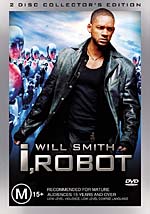 The Birds
The Birds
1963
Director: Alfred Hitchcock
Starring: Rod Taylor, Jessica Tandy, Suzanne Pleshette, Tippi Hedren and Veronica Cartwright
 I, Robot
I, Robot
2004
Director: Alex Proyas
Starring: Will Smith, Bridget Moynahan, Alan Tudyk, James Cromwell and Bruce Greenwood
Both were (very loosely) based on a short story (or stories) written in the mid-20th century. Both use ground-breaking (for their times) special effects. Both deal with a rebellion by the innocuous. Both attempt to create that sense of dread more familiar from the zombie movie: they keep on coming, they won't ever stop.
Birds does that better. It grinds the viewer down with the relentless advance of the adversary, nothwithstanding anything that the human players can do. Every new scene there are still more of them. Building, ever building.
The special effects -- done in the 1963 equivalent of green screen -- relied on 'sulfur lighting' to allow characters to be placed over backgrounds, and birds to be placed over them. Some of the time. Small use was also made of mechanical birds, but many of the actors (even the children) had to undergo having various birds wired to them to assist in their peckathons.
The liberal use of blood, which must have been quite shocking at the time, has relatively little effect upon the jaded 2004 viewer. Still, the visuals overall range from nearly acceptable to excellent.
The film quality was adequate, even though presented in 4:3 rather than the original theatrical 1.85:1 aspect ratio. It's unclear whether this DVD is a pan and scan of the movie, or simply has the full film frame restored (Hitchcock used a spherical, not anamorphic, lens). There is quite a bit of film grain, but the most irritating defect is intentional: a soft focus was used on the female lead Tippi Hedren, presumably intended to make her look even more beautiful than she was (at 32 years old, perhaps some incipient wrinkles needed disguising). During cuts in conversations, the contrast with the other participant's sharp focus was most disconcerting.
I couldn't help but think during the final attack on the house how much better it could be done today. Surround sound, the birds shrieking at earbursting levels, instead of mono constrained by an optical soundtrack, and the terror would be raised to heart-attack level.
Isaac Asimov, the author of the short stories ultimately collected into the volume I, Robot, was not very good at writing characters. But he was superb at teasing out the implications of ideas. In his Robot stories the famous 'Three Laws of Robotics' were built into robots to sooth the nerves of a frightened humanity. The engine of each story was a kind of diagnostic exploration of a robot 'malfunction', which in each case turned out to be an unintended consequence of the Three Laws.
But the exciting promotional trailers for the movie suggested Robots running around, kicking human ass, which is directly contrary to the First Law. No wonder Asimov fans were disgruntled.
Happily they were wrong. Australian director Alex Proyas showed himself to be a sensitive interpreter of the spirit of Asimov. And a translator to 21st century movie idiom: notice the liberal sloganisation of the three laws into 'Three Laws Safe'. The action and plot directly flow from, not contrary to, the Three Laws. And in further homage to Asimov, although still fundamentally an action piece, the movie is also structured as a crime mystery, a form frequently also used by Asimov.
The action is thrilling, even if the neverending hoards of Robots do not manage to instill quite so much dread of the inevitable as Hitchcock's birds. But the special effects are better, as you'd expect, and the blatant silliness kept down to near-tolerable levels (a manual mode for cars travelling close-packed at insane speeds down multilane highways?) Some welcome reality is injected, as in Will Smith's well-conveyed physical shock after his high speed crash.
The DVD is brilliant. The picture is simply perfect, the sound even better, and with the two DVD version, there seems to be a neverending supply of special extras. I watched this movie twice in a row, the second time through just to hear Proyas' commentary track (and there are two other commentary tracks as well!). It's worth it.
Running time: 115 minutes
Aspect: 4:3 (4.26Mb/s average video bit rate)
Sound track: English, German: Dolby Digital 2/0.0 (mono), 192kb/s
Subtitles: English, Dutch, German, Swedish, Danish, Norwegian, Finnish
Features: Documentary: 'All About the Birds' (80 mins); Production photographs (85 stills); Original ending (script shots and sketches only); Deleted scene (stills and script shots only); Tippi Hedren's screen test (10 mins); Universal News Reel (1963) (B&W) (3 mins), Booklet
Running time: 110 minutes
Aspect: 2.35:1 anamorphic (5.21Mb/s average video bit rate)
Sound track: English: Dolby Digital 3/2.1, 448kb/s & DTS 3/2.1, 768kb/s; Three commentary tracks: Dolby Digital 2/0.0, 192kb/s
Subtitles: English, English (Commentary), English (Commentary), English (Commentary)
Features: DISC 1: Featurette: 'The Making Of I, Robot' (13 mins); Assorted trailers for other movies and DVDs; Photo gallery (30 stills); DISC 2: Some six hours of featurettes